
Lycaenidae is the second-largest family of butterflies, with over 6,000 species worldwide, whose members are also called gossamer-winged butterflies. They constitute about 30% of the known butterfly species.

Riodinidae is the family of metalmark butterflies. The common name "metalmarks" refers to the small, metallic-looking spots commonly found on their wings. The 1,532 species are placed in 146 genera. Although mostly Neotropical in distribution, the family is also represented both in the Nearctic, Palearctic, Australasian (Dicallaneura), Afrotropic, and Indomalayan realms.
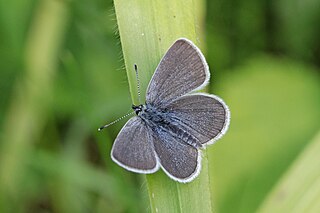
The small blue is a Palearctic butterfly in the family Lycaenidae. Despite its common name, it is not particularly blue. The male has some bluish suffusion at the base of its upper wings but is mostly dark brown like the female. The species can live in colonies of up to several hundred and in its caterpillar stage is cannibalistic.

Cyaniris semiargus, the Mazarine blue, is a Palearctic butterfly in the family Lycaenidae.
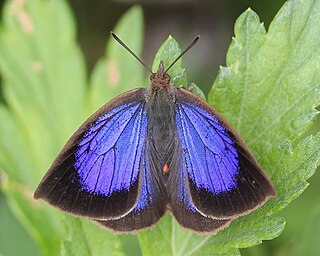
Arhopala is a very large genus of gossamer-winged butterflies (Lycaenidae). They are the type genus of the tribe Arhopalini. In the relatively wide circumscription used here, it contains over 200 species collectively known as oakblues. They occur from Japan throughout temperate to tropical Asia south and east of the Himalayas to Australia and the Solomon Islands of Melanesia. Like many of their relatives, their caterpillars are attended and protected by ants (myrmecophily). Sexual dichromatism is often prominent in adult oakblues.
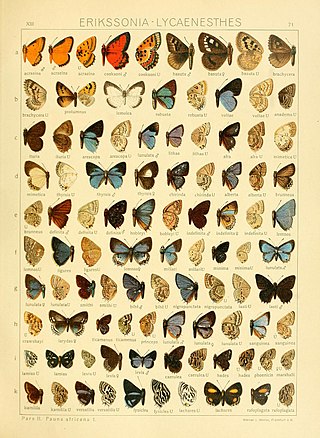
Anthene is a genus of butterflies in the family Lycaenidae, commonly called the ciliate blues or hairtails. The genus was erected by Edward Doubleday in 1847.
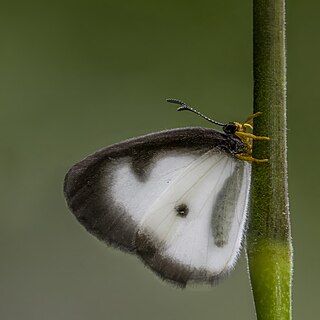
Ornipholidotos is a genus of butterflies, commonly called glasswings or white mimics, in the family Lycaenidae. The species of this genus are endemic to the Afrotropical realm.

Cupido is a genus of butterflies in the family Lycaenidae. The subgenus Everes is included here.

Charaxes brutus, the white-barred emperor or white-barred Charaxes, is a butterfly of the family Nymphalidae. It is found in Africa.
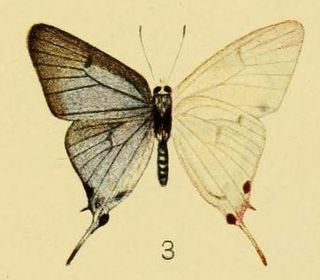
Iolaus alienus, the brown-line sapphire, is a butterfly of the family Lycaenidae. It is found in most of Sub-Saharan Africa.

Pronophilina is a Neotropical subtribe of butterflies of the subfamily Satyrinae. They are a species-rich group with highest diversity in the tropical and subtropical mountains, especially the Andes. Before 1970, they were poorly studied, but recent interest has resulted in high rates of species description from previously unexplored mountain ranges. However, there is still a lack of knowledge on their biology and ecology. Their relationship to other groups of Satyrine butterflies and their complex patterns of speciation within and among mountain ranges have led to several biogeographic discussions.

Charaxes legeri, the St. Leger's charaxes, is a butterfly in the family Nymphalidae. It is found in southern Burkina Faso, northern Benin, northern Nigeria and southern Niger. The habitat consists of woodland savanna at altitudes between 600 and 1,700 meters.

Charaxes antiquus is a butterfly in the family Nymphalidae. It is found on the island of São Tomé. The habitat consists of forests and woodland. The species was named by James John Joicey and George Talbot in 1926.
Charaxes tectonis, the mountain silver-barred charaxes, is a butterfly in the family Nymphalidae. It is found in Nigeria and Cameroon. The habitat consists of sub-montane and montane forests.
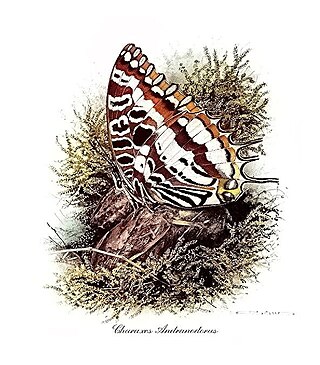
Charaxes andranodorus is a butterfly in the family Nymphalidae. It is found on Madagascar.
Charaxes musakensis is a butterfly in the family Nymphalidae. It is found in Cameroon. The habitat consists of montane forests at altitudes above 1,300 meters.
Charaxes richelmanni is a butterfly in the family Nymphalidae. It is found in Cameroon, Gabon, the Republic of Congo, the Central African Republic, the Democratic Republic of Congo and Tanzania. The habitat consists of lowland evergreen forests.
Cerautola is a genus of butterflies in the family Lycaenidae, endemic to the Afrotropical realm.

Cupido lorquinii is a small butterfly found in the West Palearctic that belongs to the blues family.














